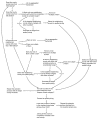Dynamic maps: a visual-analytic methodology for exploring spatio-temporal disease patterns
- PMID: 20042115
- PMCID: PMC2806342
- DOI: 10.1186/1476-069X-8-61
Dynamic maps: a visual-analytic methodology for exploring spatio-temporal disease patterns
Abstract
Background: Epidemiologic studies are often confounded by the human and environmental interactions that are complex and dynamic spatio-temporal processes. Hence, it is difficult to discover nuances in the data and generate pertinent hypotheses. Dynamic mapping, a method to simultaneously visualize temporal and spatial information, was introduced to elucidate such complexities. A conceptual framework for dynamic mapping regarding principles and implementation methods was proposed.
Methods: The spatio-temporal dynamics of Salmonella infections for 2002 in the U.S. elderly were depicted via dynamic mapping. Hospitalization records were obtained from the Centers of Medicare and Medicaid Services. To visualize the spatial relationship, hospitalization rates were computed and superimposed onto maps of environmental exposure factors including livestock densities and ambient temperatures. To visualize the temporal relationship, the resultant maps were composed into a movie.
Results: The dynamic maps revealed that the Salmonella infections peaked at specific spatio-temporal loci: more clusters were observed in the summer months and higher density of such clusters in the South. The peaks were reached when the average temperatures were greater than 83.4 degrees F (28.6 degrees C). Although the relationship of salmonellosis rates and occurrence of temperature anomalies was non-uniform, a strong synchronization was found between high broiler chicken sales and dense clusters of cases in the summer.
Conclusions: Dynamic mapping is a practical visual-analytic technique for public health practitioners and has an outstanding potential in providing insights into spatio-temporal processes such as revealing outbreak origins, percolation and travelling waves of the diseases, peak timing of seasonal outbreaks, and persistence of disease clusters.
Figures


Similar articles
-
A descriptive analysis of the spatio-temporal distribution of enteric diseases in New Brunswick, Canada.BMC Public Health. 2016 Mar 1;16:204. doi: 10.1186/s12889-016-2779-5. BMC Public Health. 2016. PMID: 26932766 Free PMC article.
-
Spatial-temporal epidemiology of human Salmonella Enteritidis infections with major phage types (PTs 1, 4, 5b, 8, 13, and 13a) in Ontario, Canada, 2008-2009.BMC Public Health. 2015 Dec 17;15:1247. doi: 10.1186/s12889-015-2592-6. BMC Public Health. 2015. PMID: 26673616 Free PMC article.
-
Detection of spatial, temporal and space-time Salmonella Heidelberg and Salmonella Typhimurium clusters in Ontario in 2015, and comparisons to known outbreaks.Zoonoses Public Health. 2020 Sep;67(6):617-628. doi: 10.1111/zph.12741. Epub 2020 Jun 19. Zoonoses Public Health. 2020. PMID: 32558392
-
Population and evolutionary dynamics in spatially structured seasonally varying environments.Biol Rev Camb Philos Soc. 2018 Aug;93(3):1578-1603. doi: 10.1111/brv.12409. Epub 2018 Mar 25. Biol Rev Camb Philos Soc. 2018. PMID: 29575449 Free PMC article. Review.
-
Deriving risk maps from epidemiological models of vector borne diseases: State-of-the-art and suggestions for best practice.Epidemics. 2020 Dec;33:100411. doi: 10.1016/j.epidem.2020.100411. Epub 2020 Oct 22. Epidemics. 2020. PMID: 33130413 Review.
Cited by
-
Food and Nutrition Systems Dashboards: A Systematic Review.Adv Nutr. 2022 Jun 1;13(3):748-757. doi: 10.1093/advances/nmac022. Adv Nutr. 2022. PMID: 35254406 Free PMC article.
-
A One Health real-time surveillance system for nowcasting Campylobacter gastrointestinal illness outbreaks, Norway, week 30 2010 to week 11 2022.Euro Surveill. 2022 Oct;27(43):2101121. doi: 10.2807/1560-7917.ES.2022.27.43.2101121. Euro Surveill. 2022. PMID: 36305333 Free PMC article.
-
Patterns of protozoan infections: spatiotemporal associations with cattle density.Ecohealth. 2010 Aug;7(1):33-46. doi: 10.1007/s10393-010-0286-1. Epub 2010 Mar 13. Ecohealth. 2010. PMID: 20229128
-
Global seasonal and pandemic patterns in influenza: An application of longitudinal study designs.Int Stat Rev. 2022 Dec;90(Suppl 1):S82-S95. doi: 10.1111/insr.12529. Epub 2022 Oct 23. Int Stat Rev. 2022. PMID: 38607896 Free PMC article.
-
Exploring Risk Factors of Recall-Associated Foodborne Disease Outbreaks in the United States, 2009-2019.Int J Environ Res Public Health. 2022 Apr 19;19(9):4947. doi: 10.3390/ijerph19094947. Int J Environ Res Public Health. 2022. PMID: 35564342 Free PMC article.
References
-
- Harrower M, Fabrikant SI. In: Geographic Visualization. Dodge M, McDerby M, Turner M, editor. New Jersey: John Wiley & Sons, Ltd; 2008. The role of map animation for geographic visualization; pp. 49–65. full_text.
-
- Yattaw NJ. Conceptualizing Space and Time: A Classification of Geographic Movement. Cartography and Geographic Information Science. 1999;26:85–98. doi: 10.1559/152304099782330734. - DOI
-
- Hald T, Andersen JS. Trends and seasonal variations in the occurrence of Salmonella in pigs, pork and humans in Denmark, 1995-2000. Berliner Und Munchener Tierarztliche Wochenschrift. 2001;114:346–349. - PubMed
Publication types
MeSH terms
Grants and funding
LinkOut - more resources
Full Text Sources
Medical

